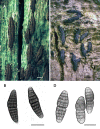A molecular phylogenetic reappraisal of the Hysteriaceae, Mytilinidiaceae and Gloniaceae (Pleosporomycetidae, Dothideomycetes) with keys to world species
- PMID: 20169023
- PMCID: PMC2816966
- DOI: 10.3114/sim.2009.64.03
A molecular phylogenetic reappraisal of the Hysteriaceae, Mytilinidiaceae and Gloniaceae (Pleosporomycetidae, Dothideomycetes) with keys to world species
Abstract
A reappraisal of the phylogenetic integrity of bitunicate ascomycete fungi belonging to or previously affiliated with the Hysteriaceae, Mytilinidiaceae, Gloniaceae and Patellariaceae is presented, based on an analysis of 121 isolates and four nuclear genes, the ribosomal large and small subunits, transcription elongation factor 1 and the second largest RNA polymerase II subunit. A geographically diverse and high density taxon sampling strategy was employed, including multiple isolates/species from the following genera: Anteaglonium (6/4), Encephalographa (1/1), Farlowiella (3/1), Gloniopsis (8/4), Glonium (4/2), Hysterium (12/5), Hysterobrevium (14/3), Hysterographium (2/1), Hysteropatella (2/2), Lophium (4/2), Mytilinidion (13/10), Oedohysterium (5/3), Ostreichnion (2/2), Patellaria (1/1), Psiloglonium (11/3), Quasiconcha (1/1), Rhytidhysteron (8/3), and 24 outgroup taxa. Sequence data indicate that although the Hysteriales are closely related to the Pleosporales, sufficient branch support exists for their separation into separate orders within the Pleosporomycetidae. The Mytilinidiales are more distantly related within the subclass and show a close association with the Gloniaceae. Although there are examples of concordance between morphological and molecular data, these are few. Molecular data instead support the premise of a large number of convergent evolutionary lineages, which do not correspond to previously held assumptions of synapomorphy relating to spore morphology. Thus, within the Hysteriaceae, the genera Gloniopsis, Glonium, Hysterium and Hysterographium are highly polyphyletic. This necessitated the transfer of two species of Hysterium to Oedohysteriumgen. nov. (Od. insidenscomb. nov. and Od. sinense comb. nov.), the description of a new species, Hysterium barrianumsp. nov., and the transfer of two species of Gloniopsis to Hysterobreviumgen. nov. (Hb. smilaciscomb. nov. and Hb. constrictumcomb. nov.). While Hysterographium, with the type Hg. fraxini, is removed from the Hysteriaceae, some of its species remain within the family, transferred here to Oedohysterium (Od. pulchrumcomb. nov.), Hysterobrevium (Hb. moricomb. nov.) and Gloniopsis (Gp. subrugosacomb. nov.); the latter genus, in addition to the type, Gp. praelonga, with two new species, Gp. arciformissp. nov. and Gp. kenyensis sp. nov. The genus Glonium is now divided into Anteaglonium (Pleosporales), Glonium (Gloniaceae), and Psiloglonium (Hysteriaceae). The hysterothecium has evolved convergently no less than five times within the Pleosporomycetidae (e.g., Anteaglonium, Farlowiella, Glonium, Hysterographium and the Hysteriaceae). Similarly, thin-walled mytilinidioid (e.g., Ostreichnion) and patellarioid (e.g., Rhytidhysteron) genera, previously in the Mytilinidiaceae and Patellariaceae, respectively, transferred here to the Hysteriaceae, have also evolved at least twice within the subclass. As such, character states traditionally considered to represent synapomorphies among these fungi, whether they relate to spore septation or the ascomata, in fact, represent symplesiomorphies, and most likely have arisen multiple times through convergent evolutionary processes in response to common selective pressures.
Keywords: Evolution; Hysteriales; Mytilinidiales; Patellariales; fungi; phylogeny; speciation; taxonomy.
Figures












Similar articles
-
On the evolution of the Hysteriaceae and Mytilinidiaceae (Pleosporomycetidae, Dothideomycetes, Ascomycota) using four nuclear genes.Mycol Res. 2009 Apr;113(Pt 4):461-79. doi: 10.1016/j.mycres.2008.12.001. Mycol Res. 2009. PMID: 19422072
-
Three New Species of Mytilinidioid Fungi (Dothideomycetes, Ascomycota) from Mexico.J Fungi (Basel). 2024 Oct 18;10(10):725. doi: 10.3390/jof10100725. J Fungi (Basel). 2024. PMID: 39452677 Free PMC article.
-
Bullatosporium taxicola, a new genus and species in Mytilinidiaceae (Pleosporomycetidae, Dothideomycetes) from western Norway.Fungal Syst Evol. 2024 Dec;14:197-207. doi: 10.3114/fuse.2024.14.13. Epub 2024 Jun 12. Fungal Syst Evol. 2024. PMID: 39830301 Free PMC article.
-
An overview of the genus Glyphium and its phylogenetic placement in Patellariales.Mycologia. 2015 May-Jun;107(3):607-18. doi: 10.3852/14-191. Epub 2015 Feb 6. Mycologia. 2015. PMID: 25661715 Free PMC article.
-
Three new species of Rhytidhysteron (Dothideomycetes, Ascomycota) from Mexico.MycoKeys. 2021 Sep 14;83:123-144. doi: 10.3897/mycokeys.83.68582. eCollection 2021. MycoKeys. 2021. PMID: 34616220 Free PMC article. Review.
Cited by
-
Additions to Rhytidhysteron (Hysteriales, Dothideomycetes) in China.J Fungi (Basel). 2023 Jan 22;9(2):148. doi: 10.3390/jof9020148. J Fungi (Basel). 2023. PMID: 36836263 Free PMC article.
-
Taxonomy and phylogeny of the novel rhytidhysteron-like collections in the Greater Mekong Subregion.MycoKeys. 2022 Jan 12;86:65-85. doi: 10.3897/mycokeys.86.70668. eCollection 2022. MycoKeys. 2022. PMID: 35095305 Free PMC article.
-
Phaeohyphomycosis Caused by Rhytidhysteron rufulum and Review of Literature.Mycopathologia. 2017 Apr;182(3-4):403-407. doi: 10.1007/s11046-016-0064-x. Epub 2016 Sep 15. Mycopathologia. 2017. PMID: 27628109 Review.
-
Revision of Xylonaceae (Xylonales, Xylonomycetes) to include Sarea and Tromera.Mycoscience. 2021 Jan 20;62(1):47-63. doi: 10.47371/mycosci.2020.11.001. eCollection 2021. Mycoscience. 2021. PMID: 37090019 Free PMC article.
-
Two unusual new species of Pleosporales: Anteaglonium rubescens and Atrocalyx asturiensis.Sydowia. 2018 May 4;70:129-140. doi: 10.12905/0380.sydowia70-2018-0129. Sydowia. 2018. PMID: 30774163 Free PMC article.
References
-
- Amano N (1983). Saprobic loculoascomycetous fungi from Japan 1. Hysteriaceous fungi. Transactions of the Mycological Society of Japan 24: 283–297.
-
- Arx JA von, Müller E (1954). Die Gattungen der amerosporen Pyrenomyceten. Beiträge zur Kryptogamenflora der Schweiz 11: 1–434.
-
- Arx JA von, Müller E (1975). A re-evaluation of the bitunicate Ascomycetes with keys to families and genera. Studies in Mycology 9: 1–159.
-
- Barr ME (1975). The genus Ostreichnion. Mycotaxon 3: 81–88.
-
- Barr ME (1979). A classification of loculoascomycetes. Mycologia 71: 935–957.
LinkOut - more resources
Full Text Sources
Molecular Biology Databases
Research Materials
